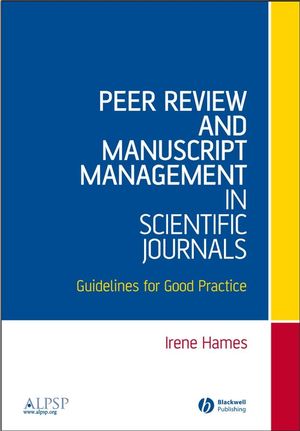Peer Review and Manuscript Management in Scientific Journals: Guidelines for Good PracticeISBN: 978-1-4051-3159-9
Paperback
306 pages
April 2007, Wiley-Blackwell
 This is a Print-on-Demand title. It will be printed specifically to fill your order. Please allow an additional 15-20 days delivery time. The book is not returnable.
|
||||||
Preface.
1. Introduction.
What should peer review do?.
What does peer review assume?.
What is this book trying to achieve?.
2. The peer-review process – how to get going.
The basic process.
The people involved in running the peer-review process.
Office organization.
Choice of system and procedures.
3. Manuscript submission and initial checks on completeness and suitability.
Submission guidance to authors.
Checking and logging of submitted manuscripts.
Transfer to editor.
Initial assessment of suitability and rejection without external review.
Manuscripts with language problems.
4. The full review process.
Identifying and selecting appropriate reviewers.
Finding reviewers.
Getting the manuscript and associated material to the reviewers.
Monitoring review progress.
Receiving and checking of returned reviews.
Back-to-back manuscripts.
Dealing with enquiries on manuscript status.
5. The decision-making process for reviewed manuscripts.
The organizational structure for decision making.
The decision-making process.
Checks to be made before communicating decisions to authors.
Communicating the decision to the authors.
Rebuttals and appeals from authors.
Dealing with revisions.
Dealing with resubmissions.
Acceptance.
Decision making to consistent standards and the problem of availability of space.
Special considerations in decision making: dual-use research and the possible misuse of information.
6. Moving to online submission and review.
How do you choose an online system?.
How to prepare to move to online working.
The launch and transition period.
What to expect after going live online.
Problems that may be encountered and how to deal with them.
A final note.
7. Reviewers – a precious resource.
Thanks and feedback to reviewers.
Reviewer training.
Ways to recompense reviewers.
How to develop and maintain reviewer loyalty.
Recognition of peer review as an accredited professional activity.
8. The obligations and responsibilities of the people involved in peer review.
Authors – their obligations and responsibilities.
Editors – their obligations and responsibilities.
Reviewers – their obligations and responsibilities.
Editorial office staff – their obligations and responsibilities.
Conflicts of interest – what they are and how to deal with them.
Moral dilemmas.
9. Misconduct in scientific research and publishing – what it is and how to deal with it.
What types of misconduct can occur?.
How should cases of alleged or suspected misconduct be handled?.
Where can you turn for help?.
What sanctions can be imposed as a penalty for misconduct?.
Correcting the literature.
Dubious or fraudulent data remaining in the literature.
The future.
Appendix I The Golden Rules and the Peer-Review Good Practice Checklist.
Appendix II Examples of checklists, forms, guidance for reviewers and editorial letters.
Appendix III Useful websites.
Appendix IV Alternative models of peer review.
Index



